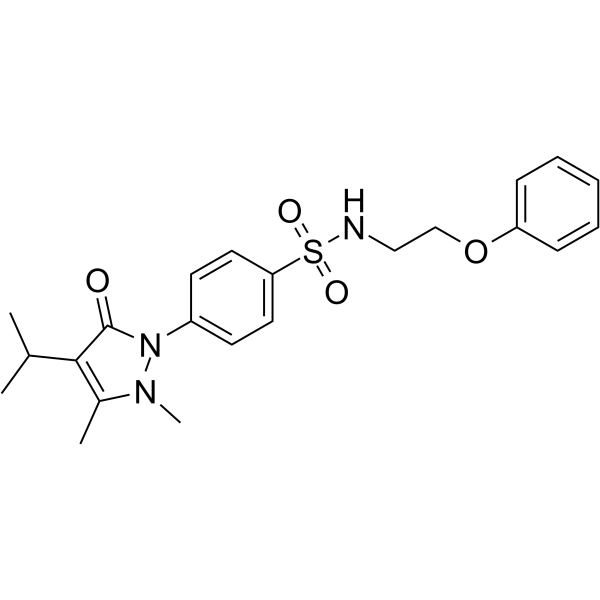Physicochemical Properties
| Molecular Formula | C22H27N3O4S |
| Exact Mass | 429.17 |
| Elemental Analysis | C, 61.52; H, 6.34; N, 9.78; O, 14.90; S, 7.46 |
| CAS # | 695207-56-8 |
| PubChem CID | 4917788 |
| Appearance | White to off-white solid powder |
| LogP | 2.4 |
| Hydrogen Bond Donor Count | 1 |
| Hydrogen Bond Acceptor Count | 6 |
| Rotatable Bond Count | 8 |
| Heavy Atom Count | 30 |
| Complexity | 730 |
| Defined Atom Stereocenter Count | 0 |
| InChi Key | SQYWMHPZMHDCHP-UHFFFAOYSA-N |
| InChi Code | InChI=1S/C22H27N3O4S/c1-16(2)21-17(3)24(4)25(22(21)26)18-10-12-20(13-11-18)30(27,28)23-14-15-29-19-8-6-5-7-9-19/h5-13,16,23H,14-15H2,1-4H3 |
| Chemical Name | 4-(2,3-dimethyl-5-oxo-4-propan-2-ylpyrazol-1-yl)-N-(2-phenoxyethyl)benzenesulfonamide |
| Synonyms | BC-LI 0186; BC-LI-0186; BC-LI0186; BCLI 0186; BCLI0186; BCLI-0186 |
| HS Tariff Code | 2934.99.9001 |
| Storage |
Powder-20°C 3 years 4°C 2 years In solvent -80°C 6 months -20°C 1 month |
| Shipping Condition | Room temperature (This product is stable at ambient temperature for a few days during ordinary shipping and time spent in Customs) |
Biological Activity
| Targets | LeuRS and RagD interaction ( IC50 = 46.11 nM ); LeuRS and RagD interaction ( Kd = 42.1 nM ) |
| ln Vitro | BC-LI-0186 inhibits both mTORC1 activity and the lysosomal localization of LRS by binding to the RagD interacting site of LRS. Additionally, BC-LI-0186 successfully inhibits the growth of rapamycin-resistant cancer cells as well as the activity of MTOR mutants linked to cancer.[1] |
| ln Vivo | BC-LI-0186 (intraperitoneal injection; 50 mg/kg; for two weeks; administered alone or in combination with cisplatin alone; administered five days a week) shows antitumor effects and, in an animal model of lung cancer with LSL K-ras G12D, significantly reduces tumor size when compared with treatment with vehicle.[1] |
| Cell Assay | Leucine-free medium is used to starve the cells for ninety minutes. After that, they are placed in serum-free media for fifteen minutes, one and a half hours, or six hours. Additionally, the matching antibodies are used to analyze the cell lysates. |
| Animal Protocol |
K-ras mouse lung cancer model, LSL K-ras G12D lung cancer mouse model 50 mg/kg i.p. |
| References |
[1]. Control of leucine-dependent mTORC1 pathway through chemical intervention of leucyl-tRNA synthetase and RagD interaction. Nat Commun. 2017 Sep 29;8(1):732. |
Solubility Data
| Solubility (In Vitro) | DMSO : 86~125 mg/mL (200.2~291.0 mM) |
| Solubility (In Vivo) |
Solubility in Formulation 1: ≥ 2.08 mg/mL (4.84 mM) (saturation unknown) in 10% DMSO + 40% PEG300 + 5% Tween80 + 45% Saline (add these co-solvents sequentially from left to right, and one by one), clear solution. For example, if 1 mL of working solution is to be prepared, you can add 100 μL of 20.8 mg/mL clear DMSO stock solution to 400 μL PEG300 and mix evenly; then add 50 μL Tween-80 to the above solution and mix evenly; then add 450 μL normal saline to adjust the volume to 1 mL. Preparation of saline: Dissolve 0.9 g of sodium chloride in 100 mL ddH₂ O to obtain a clear solution. Solubility in Formulation 2: ≥ 2.08 mg/mL (4.84 mM) (saturation unknown) in 10% DMSO + 90% Corn Oil (add these co-solvents sequentially from left to right, and one by one), clear solution. For example, if 1 mL of working solution is to be prepared, you can add 100 μL of 20.8 mg/mL clear DMSO stock solution to 900 μL of corn oil and mix evenly. (Please use freshly prepared in vivo formulations for optimal results.) |
